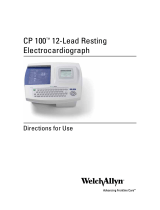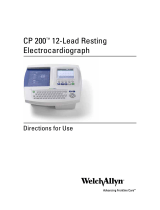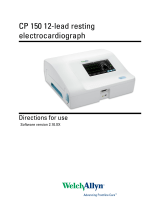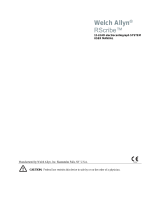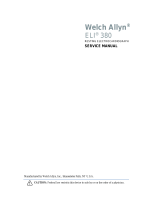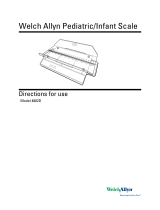Page is loading ...

CP Series
Electrocardiographs
Update to Directions for Use
CP 100
CP 200

ii Welch Allyn CP Series Electrocardiographs
Copyright 2012 Welch Allyn
Mat. Number: 719375, Ver: A
www.welchallyn.com
Welch Allyn
4341 State Street Road
Skaneateles Falls, NY 13153
USA
Regulatory Affairs Representative
Welch Allyn Limited
Navan Business Park
Dublin Road
Navan, County Meath, Republic of Ireland
USA 1 800 535 6663
+ 1 315 685 4560
Australia + 61 2 9638 3000
Canada 1 800 561 8797 China + 86 216 327 9631
European Call Center + 353 46 906 7790 France + 33 155 69 58 49
Germany + 49 695 098 5132 Japan + 81 42 703 6084
Latin America + 1 305 669 9003 Netherlands + 31 202 061 360
Singapore + 65 6419 8100 South Africa + 27 11 777 7555
United Kingdom + 44 20 7365 6780 Sweden + 46 85 853 65 51

1
Update Through Software Version 2.6
This update describes changes in operation through software version 2.6 of the CP 100
and CP 200 electrocardiographs and the CP 200 spirometry option. This document
supplements information in the following manuals:
• CP 100 12-Lead Resting Electrocardiograph Directions for Use
• CP 200 12-Lead Resting Electrocardiograph Directions for Use
• CP 200 Spirometry Option Directions for Use
Updated USB drivers for Windows 7 32-bit and 64-bit operating systems
Enables connectivity to CardioPerfect Workstation (CPWS).
Support for lithium ion battery
• The lithium ion battery features include:
• Increased operating capacity
• Long battery life
This software release includes all the previous software improvements.
Updated Battery Information for the CP 100/CP 200
WARNING Lithium ion battery. Risk of fire, explosion, and burns. Do not short-
circuit, crush, incinerate, or disassemble the battery pack. Never dispose of
batteries in refuse containers. Always recycle batteries according to local
regulations.
Caution If you only install the 2.6 software without upgrading to a lithium ion
battery an incorrect battery charging status will result. To continue using your
Lead-Acid battery choose System Settings > Device Configuration and then
choose the Battery Type > Lead-Acid.

2 Welch Allyn CP Series Electrocardiographs
Symbols
Updated “System Settings” Menu Tree
Rechargeable lithium ion battery China RoHS (restriction of hazardous substances)
symbols for control of pollution caused by electronic
information products. 5-year environment-friendly use
period (EFUP) for batteries.
Separate the battery from other
disposables for recycling.
Recycle
System Settings
Device
Configuration
Set Date/Time
Language
Date Format
Time Format
Weight Unit
Height Unit
Power-Save
Practice ID
Device ID
Audio Beeper
Flow Unit*
Pressure Unit*
Temperature*
Increase Display Contrast
Decrease Display Contrast
Contact Information
Printer Select
CAPS Lock
Battery Type
* Applicable for spirometry only.

Update Through Software Version 2.6 3
Selecting the Battery Type in the Device Configuration settings
1. Press the Menu key .
2. Choose System Settings > Device Configuration.
The following screen appears.
“Device Configuration” Screen
3. Choose the Battery Type settings.
• Lead-Acid
• Lithium
4. Press the Enter key .
5. Choose the Previous Menu.
Reviewing the Device Information
1. Press the Menu key .
2. Choose System Settings > Device Info.
The following screen appears.
“Device Info” Screen
3. Select About.
Device Configuration
1 Set Date/Time
2 Language
3 Date Format
4 Time Format
5 Weight Unit
6 Height Unit
7 Power-Save
8 Practice ID
I CAPS Lock
J Battery Type
9:17AM Oct 16 12
Lead-Acid
Lithium
Lead-Acid
Lithium ion
Device Info
1 About
9:17AM Oct

4 Welch Allyn CP Series Electrocardiographs
Scroll to the bottom of the list to view your battery type (either Lead-Acid or Lithium).
Battery Specifications
Item Description
About Displays the following information about the electrocardiograph:
• serial number
• modules configured
• version numbers
• battery voltage
• battery current
• battery type
Rechargeable Battery Specification
Lithium ion
Lithium iron phosphate, 6 volt, 6 AH
Prints up to 100 continuous ECGs per charge
12-hour recharging
Lead-Acid Lead-Acid gel, 6 volt, 5 AH
Prints up to 100 continuous ECGs per charge
12-hour recharging

Feature updates prior to the 2.6 software release 5
Feature updates prior to the 2.6
software release
If your CP 100 electrocardiograph has a serial number of 10020000, or greater, or your
CP 200 electrocardiograph has a serial number 20020000, or greater, this update
describes the changes in the operation of your electrocardiograph.
If your electrocardiograph has a serial number that is lower than 1002000 or 2002000, and
your device was recently serviced, it may contain some or all of these new features
depending on the scope of the services performed.
This document supplements information in the following manuals:
• CP 100 12-Lead Resting Electrocardiograph Directions for Use (mat. 708794)
• CP 200 12-Lead Resting Electrocardiograph Directions for Use (mat. 708793)
• CP 200 Spirometry Option Directions for Use (mat. 708795)
Battery Deep-Discharge Disconnect Added
A battery deep-discharge disconnect has been added to reduce the likelihood that your
CP 100 or CP 200 electrocardiograph will operate on a deeply discharged battery. The
disconnect prevents permanent damage to the battery when the battery is left uncharged
for long periods of time.
This functions automatically when the electrocardiograph battery voltage is less than
5.25V in sleep mode. Once a battery disconnect has occurred, the electrocardiograph will
not operate on battery power until it is charged to 6.2V or higher. This also protects the
electrocardiograph from operating on a malfunctioning battery that cannot be charged to
6.2V or higher.
Reset Button
If the electrocardiograph stops functioning, you can press and hold the Power On/Off key
for approximately 7 seconds to restart the electrocardiograph. Release the key once the
restart begins. The key is located on the upper left of the electrocardiograph keyboard.
Figure 1. Reset Button
The previous method of resetting the electrocardiograph is still available. Reset the
electrocardiograph by pressing the reset button located on the right side. To press the
1
!
2
@
3
#
4
$
5
%
6
+
7
-
8
*
9
(
0
)
1
!
2
@
3
#
Press and hold

6 Welch Allyn CP Series Electrocardiographs
reset button, insert a small object, such as small paper clip, into the hole next to the
Spirometry port.
Bi-Colored Keyboard LED
Figure 2. Keyboard LED
The bi-colored LED on the keyboard
indicates the battery status. When green,
the LED indicates that AC power is
present. When yellow, the LED indicates a
low battery that should be charged. The
LED is located below the Power On/Off
key on the upper left of the
electrocardiograph keyboard.
Alternate Patient Cable and Leads
The Lead configuration has changed so that all individually replaceable lead wires extend
from the same end of the patient cable. This new configuration is intended to make the
connection of the lead wires easier for you. It is different now than it has been in previous
models where the LL (F) and RL (N) leads attached to the opposite end of the patient
cable with respect to the other leads. See Figure 3“Patient Cable and Leads”.
Figure 3. Patient Cable and Leads
There has been no change to the replaceable lead wires. They remain compatible with
previous models and are equivalent in function.
1
!
2
@
3
#
4
$
5
%
6
+
Bi-colored LED
Left leg lead
Right leg lead
Chest leads
Cable
rakes
Electrocardiograph
connector
Right arm lead
Left arm lead

Feature updates prior to the 2.6 software release 7
Connecting the Patient Cable
Insert all leads into their proper positions, as labeled on the connectors. See Figure 4
“Inserting the Leads”.
Figure 4. Inserting the Leads
Updated Information for the CP 100/CP 200
Heart rate monitor operation
The heart rate indicated on the CP 100 or CP 200 LCD display is for reference only. Make
manual measurements of the ECG intervals and magnitudes on printed ECG reports only.
The increased R wave amplitudes that are produced by some patient simulators may
produce heart rate readings two times higher than normal because the R waves can be
counted as T waves.
The CP 100 and CP 200 devices are not intended to be used as heart rate monitors. Heart
rate monitors are covered by other standards for example: ANSI/AAMI standard EC13:
Cardiac monitors, heart rate meters and alarms.
Artifact
A combination of abnormally large R wave amplitude and waveform shapes delivered by
some patient simulators can trigger artifact warnings. These warnings are not consistent
with actual patient morphologies. The noise warning is designed as a guide to limit low
quality ECGs.
The CP 100 and CP 200 devices are compliant to all applicable standards specified in the
device manual for diagnostic electrocardiographs including: IEC/EN 60601-2-51 and ANSI/
AAMI EC11.
Reducing Artifact
• Use only resting tab electrodes that have not past their product expiration date.
Store only in an air tight pouch within the product recommended environmental
conditions.
• When using the reusable bulbs, limb plates, or clamp electrodes, always replace
expired or dried up electrode gel.
• When using the reusable bulbs, limb plates, or clamp electrodes, use only an
ECG conductive gel to obtain optimum conductivity. Do not use ultrasound gel.
• Orient the adapter (alligator) clips so that the metal from the clip is able to make
contact with the conductive area of the resting tab electrode.

8 Welch Allyn CP Series Electrocardiographs
• Replace the patient lead if the banana spring at the end of the lead is broken or
damaged.
Updated Battery Information for the CP 100/CP 200
Electrocardiograph Battery - Preparation and Operation
Battery performance:
The sealed lead-acid battery provides 200 to 300 discharge/charge cycles under normal
operating conditions before it should be replaced. Typical battery usage will require
battery replacement approximately once per year. Reduced battery performance and
longevity will result if the recommendations for maximum battery performance are not
followed.
The electrocardiograph uses a single, rechargeable Sealed Lead Acid (SLA) battery pack. It
is designed to print up to 100 continuous rhythm ECG pages or to print 25 AUTO ECG
tests per full charge. The typical charge time of the sealed lead-acid battery is 12-16 hours,
but can take up to 36 hours for a highly discharged battery.
Prior to using your new electrocardiograph in battery mode:
Caution Charge the Battery. Upon receipt of your new electrocardiograph, it is
important to charge the electrocardiograph's battery for at least 12 hours before
using it in battery mode.
Note
The electrocardiograph is fully functional when connected to AC power,
regardless of the battery charge state. Using the electrocardiograph while
charging the battery does not affect the charge time.

Feature updates prior to the 2.6 software release 9
For maximum battery performance and longevity:
• Charge the battery whenever possible by connecting the electrocardiograph to AC
power after each use.
The CP 100/CP 200 provides a trickle charge to keep the battery fully charged.
Continuous charging will maximize the battery performance and longevity and will
not overcharge or degrade the battery.
• Fully recharge the battery immediately after it becomes fully discharged. A fully
discharged battery without an immediate recharge may require an extended charge
time (up to 36 hours) and permanently degrade battery performance and longevity.
• Use only the CP 100/CP 200 electrocardiograph's integral charger to recharge the
battery.
• Use only a Welch Allyn CP 100/CP 200 approved replacement battery (REF 100660).
• Avoid using or storing your electrocardiograph in hot locations or in direct sunlight.
To check the battery charge status:
To fully charge the battery, leave the electrocardiograph plugged into AC power until you
see the fully charged indication on the display. A battery status symbol appears in the top
portion of the electrocardiograph display:
Battery is charging
Battery fully charged (symbol will
appear solid white on the
electrocardiograph display)
Note
Replace your battery if you are unable to perform your expected number of ECGs
per day after a full charge cycle. (12 hour minimum, up to 36 hours if deeply-
discharged).
Electrocardiograph
Display

10 Welch Allyn CP Series Electrocardiographs
Update Through Software Version 2.5
This update describes changes in operation through software version 2.5 of the CP 100
and CP 200 electrocardiographs and the CP 200 spirometry option. This document
supplements information in the following manuals:
• CP 100 12-Lead Resting Electrocardiograph Directions for Use (mat. 708794)
• CP 200 12-Lead Resting Electrocardiograph Directions for Use (mat. 708793)
• CP 200 Spirometry Option Directions for Use (mat. 708795)
Lead Quality Feedback
CP 100, CP 200
Lead quality messages, which appear on various screens, now include both lead-off and
artifact information.
For good quality recordings, leads must be connected and artifact free. If you print an
Auto ECG despite lead-off or artifact conditions (by overriding the “Waiting for 10 seconds
of quality data” message), the report reflects those conditions. In the case of lead-off
signals, the report shows square waves. In the case of artifact, the report might include a
warning to use the interpretation (if any) with caution.
To eliminate artifact, you might need to re-prep the patient, use fresh electrodes, or
minimize patient motion during the recording.
For additional feedback on lead quality, you can now enable an artifact report. This report,
a 12x1 format with all filters disabled, shows the leads with artifact so that you can
remedy the problem. (The normal Auto ECG report with filters enabled might mask some
of the artifact issues.) When enabled, the artifact report prints automatically with the Auto
ECG report whenever artifact is detected and you override the “Waiting for 10 seconds of
quality data” message.
To enable the artifact report, press the Menu key . Choose ECG Settings >
Auto Report Settings > Artifact Report > On.
Heart Rate
CP 100, CP 200
A four-beat average heart rate (HR) now appears in real time on the screen.
Body Mass Index
CP 100, CP 200
The patient’s body mass index (BMI) now appears on the Enter New Patient screen and
on ECG and spirometry reports when height and weight are entered.
Compliance With 60601-2-51
CP 100, CP 200
The electrocardiograph is in compliance with regulatory standards CAN/CSA C22.2
No. 60601.2.51 and IEC/EN 60601-2-51. For manufacturer's disclosures regarding
60601-2-51, please contact Welch Allyn Customer Service at the phone number listed in
the Directions for Use.

Update Through Software Version 2.5 11
Pacemaker Detection Prompt
CP 100, CP 200
If the software detects the possible presence of a pacemaker, it now asks you whether
the patient has a pacemaker. If you say no, interpretation (if purchased) is included in the
report. If you say yes, interpretation is not included in the report. This prompt was added
to prevent false pacemaker pulses caused by environmental interference.
Symbols and International Characters
CP 100, CP 200
You can now enter symbols and international characters using the keyboard.
To enter a symbol, hold the Shift key while pressing a number key. To enter an
international character, hold the Ctrl key while pressing a key with an international
character above it on the keyboard label. To capitalize an international character, hold
Shift + Ctrl while pressing the key.
CAPS Lock
CP 100, CP 200
You can now turn CAPS Lock on and off in the software. This feature works just like a
standard Caps Lock key.
To turn CAPS Lock on or off, press the Menu key .
Choose System Settings > Device Configuration > CAPS Lock > On or Off.
Swedish, Danish, and Finnish Patient ID Processing
CP 100, CP 200
When you enter a valid Swedish, Danish, or Finnish patient ID, the patient’s date of birth/
age, gender, and race are now automatically filled in.
“Repeat Test” Softkey
CP 200
The ECG post-print screen now includes a Repeat Test softkey to let you more efficiently
repeat a test.

12 Welch Allyn CP Series Electrocardiographs
Test Directory Usability
• CP 200
More convenient searching
When searching the test directory, you can now enter partial search criteria in the
Patient ID or Last Name fields. For example, to find all patient IDs starting with 12
(including 129374, 12579-125, and 12049-7564), you would enter 12 in the Patient ID
field. To find all patients with last names starting with Jo (including Jones, Johnson,
and Johnston) you would enter Jo in the Last Name field.
Note: Searching is case-insensitive.
• Flexibility in selecting tests from search results
You can now select tests from test directory search results in various ways instead of
all tests being automatically selected.
To select a contiguous group of tests, press and hold Shift while pressing an arrow
key. To select an individual test, press an arrow key. To select all tests, press Ctrl-A.
• Ability to delete saved tests
To delete tests, press the Menu key . Choose Test Directory. Fill in the criteria,
and press Search. In the Search Results screen, choose the tests that you want to
delete. Press the Delete softkey.
External Printer
CP 100, CP 200
You can now connect an external printer. It must be a USB inkjet or laser printer that
supports PCL (printer control language), such as the following:
Printouts are always black and white.
When the external printer is selected in the Device Configuration screen and is powered
on and connected to the electrocardiograph, it prints the following:
• Auto ECG reports
• Spirometry reports (CP 200 spirometry option only)
• Device settings
• Audit trails (CP 200 only)
• Help pages
Rhythm ECGs always print to the internal printer.
To connect a printer, simply connect one end of a USB cable to the printer’s USB
connector, and connect the other end to the electrocardiograph’s USB connector.
No special software is required.
Vendor Model PCL Version
HP Deskjet 995c PCL 3
HP Deskjet 5650 PCL 3 enhanced
HP Laser 1022 PCL 5E
Dell Laser 1710 PCL 5E & PCL 6
Lexmark Laser E240 PCL 6

Update Through Software Version 2.5 13
To select a printer, press the Menu key .
Choose System Settings > Device Configuration > Printer Select > Internal or
External.
Removable USB Storage Devices
CP 100, CP 200
You can now send tests to removable USB storage devices. If both an SD memory card
and a USB storage device are connected, files are sent to the SD card. The capacity of an
SD card must be >64MB,<2GB.
Contact Information for Accessories
CP 100, CP 200
It is now possible to enter contact information that will appear on the accessories
Help page.
To enter or review the contact information, press the Menu key . Choose
System Settings > Device Configuration > Contact Information.
Reset Button
CP 100, CP 200
If the electrocardiograph is unresponsive for an extended time, it might be “frozen.”
If this occurs, reset the electrocardiograph by pressing the reset button located on the
right side. To press the reset button, insert a small object, such as small paper clip, into
the hole.
WARNING All signal input and output (I/O) connectors are intended for
connection of only devices complying with IEC 60601-1, or other IEC standards
(for example, IEC 60950), as appropriate to the device. Connecting additional
devices to the electrocardiograph might increase chassis or patient leakage
currents. To maintain operator and patient safety, consider the requirements of
IEC 60601-1-1. Measure the leakage currents to confirm that no electric shock
hazard exists. In the case of a USB printer, the printer (non-medical electrical
equipment) shall be situated outside the patient environment (reference IEC
60601-1-1). The printer used should be approved to the appropriate safety
standard for non-medical electrical equipment (IEC 60950, or its national variants),
and use of an isolation transformer is recommended. If there is a requirement for
the printer to be situated within the patient environment it is the responsibility of
the user to ensure that the system provides a level of safety in compliance with
IEC 60601-1 and 60601-1-1.
Note
The CP 100 and CP 200 do not support SD card capacities greater than 2 GB
including SDHC and SDXC high capacity SD card formats, or other USB storage
devices that have software applications pre-installed such as SanDisk U3 Smart
technology.

14 Welch Allyn CP Series Electrocardiographs
Improved Battery Status Feedback
CP 100, CP 200
Whenever the battery is charging and is not yet fully charged, this icon appears: .
For maximum battery performance, as often as possible leave the electrocardiograph
plugged in until you see the “fully charged” icon: .
New Auto ECG Report Format
CP 100, CP 200
There is a new Auto ECG report format: 2x6 +1R (2 rows x 6 columns + 1 rhythm lead).
Configurable Default Rhythm Speed
CP 200
You can now change the default rhythm speed: 10, 25, or 50 mm/s.
To change this default, press the Menu key . Choose ECG Settings >
Rhythm Report Settings > Default Rhythm Speed.
Transferable Configurations
CP 100, CP 200
You can now transfer the configuration of one electrocardiograph to another (CP 200 to
CP 200, or CP 100 to CP 100). If you have the spirometry option, its configuration is
included in the transfer.
To transfer a configuration, follow these steps:
1. Insert a storage device (SD memory card or USB flash drive) into an
electrocardiograph that is configured as desired.
2. Press the Menu key .
3. Choose System Settings > Device Info > Manage Settings > Export Files >
Export Configuration Files.
4. The files are copied to the storage device.
5. Remove the storage device, and insert it into another electrocardiograph of the
same model.
6. Choose System Settings > Device Info > Manage Settings > Import Files >
Import Configuration Files.
Reset button

Update Through Software Version 2.5 15
7. The files are copied to the electrocardiograph, and then it reboots.
Configuration file
or

16 Welch Allyn CP Series Electrocardiographs
Spirometry Improvements
• CP 200 Spirometry Option
Quicker access to spirometry settings
When the electrocardiograph is in spirometry mode, the Menu key now
immediately opens the Spirometry Settings menu.
• PCP mode adjustments
In PCP mode, the V/T scaling was changed to AUTO, so the PCP printout now fits on
a single page.
• Physician's comments page
You can now choose whether spirometry reports include an additional blank page
(with patient information at the top) for physician to write comments on.
To determine whether this page prints with your reports, while in spirometry mode
press the Menu key . Choose Print Settings > Physician’s Comments >
Yes or No.
• Correction in Viljanen profile
The CP 200 Spirometry Option Directions for Use (mat. number 703411) indicates
that the Viljanen norm supports FEF25. It does not. It supports FEF75.
• Protocol settings disabled
When a spirometry protocol is selected (PCP, NIOSH, OSHA, or SSD), its settings are
now disabled in the settings menus. This change avoids confusion during setup.
• ATS/ERS 2005 compliance
The software is now compliant with ATS/ERS 2005 guidelines.
• Effort automatic stop
The device now stops automatically after meeting the ATS end-of-test criteria. You do
not have to press the Stop softkey.
• Ability to turn off “Smoke Years” and “Packs Per Day”
You can now choose whether the fields “Smoke Years” and “Packs Per Day” will
display and print. To turn these fields on or off, while in spirometry mode press the
Menu key . Choose Patient Data Settings > Smoke Years or Packs Per Day >
On or Off.
• More norms supported
The software now supports these additional predictive norms: Roca 1986,
Hedenström 1986 - females, Falaschetti 2004, Gore 1995, Forche II, Paoletti 1986,
Hibbert 1989, Wang 1993. For details on these norms, see the updated chart on the
following page.
Note
For spirometry tests, the temperature and atmospheric pressure that you enter must be within these ranges:
Temperature: 10–40 C, 50–104 F
Pressure: 600–1100 mbar, 450–825 mmHg, 18–32 inHg, 60–110 kPa

Update Through Software Version 2.5 17
Updated norm profiles
Parameters Studied Gender Age Race
Norm Name
(Abbrev.)
FVC
FEV1
FEV1%
FEV0.5
FEV3
FEV3/FVC
FEV6
FEV1/FEV6
PEF
FEF25-75
FEF75
FEF50
FEF25
FEF0.2-1.2
FEV0.5%
Male
Female
Pediatric
Adult
Height (cm)
Weight (kg)
Smoke Years
Caucasian
Black
Hispanic
Asian
Berglund 1963
(be)
XXX X X 7 70 X
Crapo 1981 (cr) XXXXXX X X X No
M:15–91
F:17–84
X
Dockery 1983
(do)
X X X X 6–11 No 110–160 X X
ECCS/Quanjer
1993 (qu)
X X X X X X X X X X No 18–70
M:155–195
F:145–180
XX X
Falaschetti 2004
(fa)
XXX
X X No 16–94 X
Forche II (fo)
XXX X XXX
X X 5–17 18–90 X
Gore 1995 (go)
XXX XX
X X No 18–78 X
Gulsvik 2001 (gu) X X X X X X X No
M:15–91
F:17–84
M:157–194
F:146–178
X
Hedenström
1986 (he)
X X X X X X X X X No 20–70
M:160–196
F:148–183
M:55–109
F:45–94
M:5–55
F:2–53
X
Hibbert 1989 (hi)
XXX X XXX
X X 6–18 No
M:120–190
F:120–176
X
Hsu 1979 (hs) X X X X X X 7–20 No
M:111–200
F:111–180
XXX
Knudson 1976 (k) X X X X X X X X 8 90 X
Knudson 1983
(kn)
XXX XXX X X 6
M:85
F:88
M:111.8–195.6
F:106.7 –182.9
X
Koillinen 1998
(kl)
XXXX X X X X X 6–16 No X
Kory 1961 (ko) X X X X No No 18–66 X
Morris 1971 (mo) X X X X X X No 20–84 X
NHANES III (nh) X X X XXXX X X 8 80 X X X
Paoletti 1986 (pa)
XXX XX
X X 8–17 18–64 X
Polgar 1971 (po) X X X X X X 3–19 No 110–170 X
Roca 1986 (ro)
XXX XX X
X X No 20–70 X
Schoenberg 1978
(sc)
XXX X XX X X 7 18
11.7–
137.2
XX
Solymar 1980
(so)
X X X X X X X X 7–18 No X
Viljanen 1981 (vi) X X X X X X X X No 18–65 X
Wang 1993 (wa)
XXX
X X X 6–18 No X X
Zapletal 1969 (za) X X X X X X X X 6–18 No
M:118–181
F:107–173
X

18 Welch Allyn CP Series Electrocardiographs
“Intended use” statement expanded
CP 100, CP 200
The Welch Allyn electrocardiograph and spirometry products (subject devices) are
intended for use by trained operators in health facilities. The subject devices provide the
following diagnostic functions:
• Acquiring, viewing (CP 200), storing (CP 200), and printing ECG waveforms using ECG
front end modules (patient cables) and associated accessories that provide signal
acquisition for up to twelve (12) leads of patient ECG waveforms through surface
electrodes adhered to the body.
• Using optional algorithms to generate measurements, data presentations, graphical
presentations and interpretative statements on an advisory basis. These are
presented for review and interpretation by the clinician based upon knowledge of the
patient, the result of physical examination, the ECG tracings and other clinical
findings.
• Using the optional CP 200 spirometry module and associated accessories to acquire,
view, store and print measures and waveforms of pulmonary function including, but
not limited to, maximal volume and flow of air that can be moved in and out of the
patient's lungs. These measures are used in the diagnosis and monitoring of lung
diseases and interventions for the treatment of certain lung diseases. The spirometer
should only be used with patients able to understand the instructions for performing
the test.
“Indications for use” statement expanded
CP 100, CP 200
The electrocardiograph is one of the tools that clinicians use to evaluate, diagnose, and
monitor patient cardiac function.
The 12-lead ECG interpretive algorithm provides a computer-generated analysis of
potential patient cardiac abnormalities which must be confirmed by a physician with other
relevant clinical information.
The optional CP 200 spirometry module is indicated for use in clinical situations to assess
a patient's pulmonary health status and evaluate symptoms, signs, or abnormal laboratory
test results.
Spirometry is indicated for use in various common clinical situations:
• Assessing health status before a patient begins strenuous physical activity.
• Evaluating the following symptoms, signs, or abnormal laboratory tests:
Symptoms — dyspnea, wheezing, orthopnea, cough, phlegm production, chest pain
Signs — diminished breath sounds, overinflation, expiratory slowing, cyanosis, chest
deformity, unexplained crackles, shortness of breath
Abnormal laboratory tests — hypoxemia, hypercapnia, polycythemia, abnormal chest
radiographs
/
